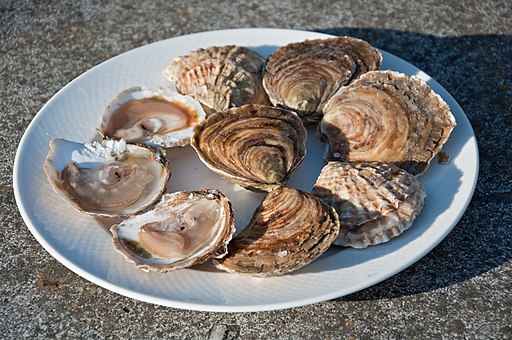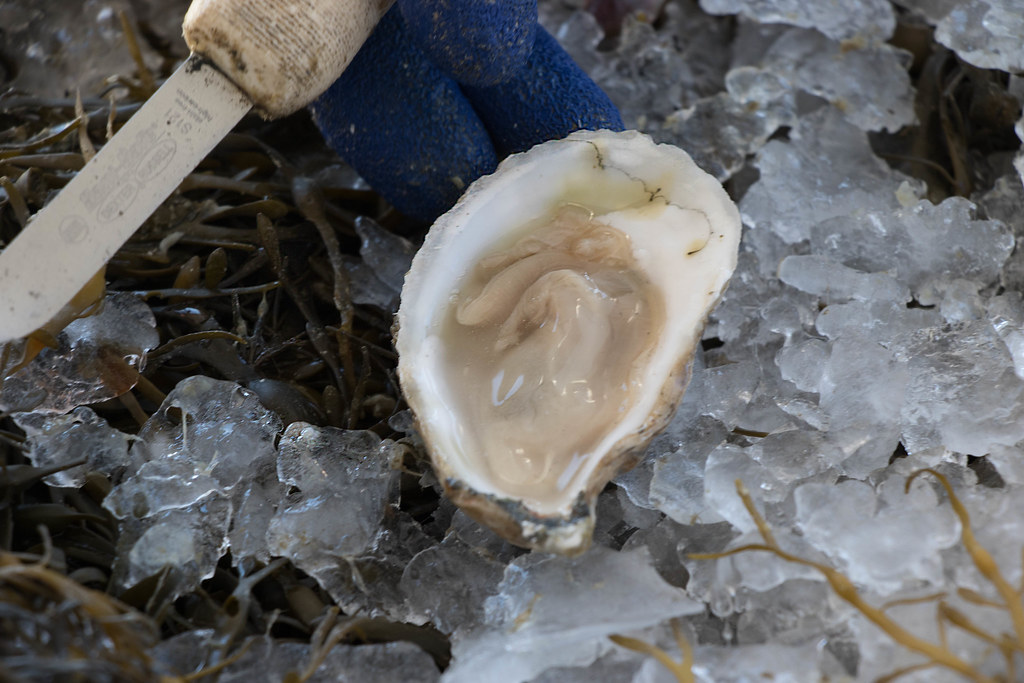Oysters
Species Description
American or Eastern oyster Crassostrea virginica
European oyster Ostrea edulis also known as flat oysters, Belons
Both species of oyster are cultured in tidal rivers and bays from hatchery-raised juveniles or “seed.”
The Eastern or American oyster is a bivalve mollusk native to the east coast of North America. Oysters were consumed by Maine’s first inhabitants thousands of years ago, as evidenced by massive, ancient shell middens along the shores of the Damariscotta River estuary. Climate changes, and later pollution, depleted populations of the shellfish in more recent times, but now they are back in Maine, thanks in part to University of Maine scientists, whose research helped the industry grow from a handful of entrepreneurs a decade ago to over 150 oyster-producing companies in Maine. Wild oysters can also be harvested in certain estuaries such as the Damariscotta River, likely offspring of nearby farmed populations.
Aquaculture has been less successful for European or flat oysters (Belons). However, a remnant population survives in the Damariscotta River and other growers are experimenting with this oyster, which can bring a higher price.
Season
Maine oysters are available year-round as many farms continue to harvest throughout the winter, but they are more plentiful from spring through fall. It is said they taste best in fall as they store fat and sugar in preparation for overwintering.
Wild harvest season for European/Belon oysters is June 15 through September 15 of the year.
Status
The annual harvest of oysters cultured in Maine waters is around seventeen million; in 2024, oysters were the third most valuable fishery in the state.
Regulatory Authority
Maine Department of Marine Resources (DMR).
Harvest Method
Oysters are raised in “floating nurseries”—different types of mesh bins or cages that float on the water surface. Once oysters grow to about the size of a quarter, they are placed in new cages or else spread on the bottom to “grow out” to harvestable size of two inches or more. This usually takes about three years, but growing conditions vary from place to place. Oysters are then harvested by hand or with a small drag. See the vessel and gear guide for more information.
Recreational Harvest
Maine growers lease areas of the state’s coastal waters and raise shellfish as private enterprise; recreational harvesting is not permitted, but some growers may offer tours of their farm. Because of cold temperatures, oysters do not usually reproduce in Maine waters. However, as water temperatures warm and in certain areas, spawning may occur and result in small pockets of wild oysters that, if large enough, may be taken with a shellfish harvesting license.
American oyster: Size limit is 2 1⁄2-inch minimum along the longest axis.
European oyster: Size limit is 3-inch minimum along the longest axis.
Towns may have more conservative size and harvest limits. Check town shellfish conservation ordinances for restrictions in the area you plan to harvest.
For more information, visit the Maine Department of Marine Resources website.
Shellfish recreational limits: The one peck per day limit is for a combined total regardless of species harvested. Towns may also require recreational licenses although the state does not require a license to harvest for personal consumption.

Health Benefits & Risks
Eastern oysters are low in fat and calories and provide an excellent source of zinc, iron and selenium. Eastern oysters are low in omega-3 fatty acids.
Oysters are filter-feeders and thus are vulnerable to bacterial pollution, chemical contamination, and harmful algal blooms (red tide), especially spring through fall. Oysters in the market and on the menu are safe, when purchased from a certified shellfish dealer. Check with the Department of Marine Resources for shellfish growing area closures; 1-800-232-4733 or 207-624-7727.
Eating raw oysters does come with some risk of exposure to viruses and bacteria, especially for people with compromised immune systems.
View the 2021 US Food and Drug Administration’s fish consumption guidelines.
Buying & Preparing
Maine oysters are typically sold under brand names that reflect their specific growing areas, and this origin should be clearly indicated at purchase.
For safety, oysters should be transported on ice and stored in the refrigerator packed loosely and covered with a damp towel. Avoid storing oysters directly on ice or submerged in freshwater, as this can kill them. Use oysters within seven days for best freshness.
Oysters are most often enjoyed raw on the half shell, served chilled with lemon, mignonette, or cocktail sauce. They also lend themselves well to cooking methods like grilling, baking, frying, or simmering in stews and chowders. When preparing at home, scrub shells clean and shuck carefully to preserve the oyster’s natural liquor and avoid injury.
Recipes
Certifications & Verifications
Links
- NOAA Fisheries Species Directory
- Resilient Shellfish: Two Kinds of Wild Oysters Make a Comeback, Maine Boats, Homes & Harbors
- Maine Oyster Cult, an article in Maine Boats, Homes, & Harbors (PDF, 1.3 MB).
- Maine’s Oyster Renaissance, an article in Maine Food & Lifestyle (PDF, 997 kb).
- The Oyster Guide from Rowan Jacobsen, author of A Geography of Oysters.
- Read The Big Oyster by Mark Kurlansky.
- Visit an oyster farm on the Maine Oyster Trail
- Learn more about the latest in oyster experiences from In A Half Shell
- Recipes and how-to-shuck video from Emily’s Oysters

